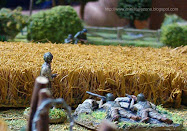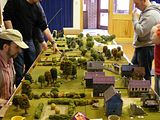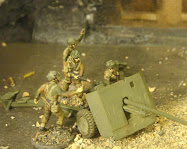
sábado, 20 de septiembre de 2008
MILITARY SYMBOLOGY.
Unit sizes.
Above the unit symbol, a symbol representing the size of the unit can be displayed. Here are the different possibilities:
Symbol
Name
Typical no. of personnel
No. of subordinate units
Typical rank of leader
XXXXXX region or theatre (rare in peacetime) 250,000 + Several army groups
US:General of the Army
XXXXX army group (rare in peacetime) 120,000 + Several armies US:General of the Army
XXXX army 100,000 Nominally several corps,but often instead divided into a larger number of divisions (e.g. five to ten) General (Gen)
XXX Corps 30,000-60,000 Several divisions Lieutenant general (Lt Gen)
XX division 10,000–20,000 Nominally several brigades or regiments,but typically about 10 battalions plus support units Major general (Maj Gen)
X brigade 2000–5000 Several regiments or battalions (Nb: Commonwealth infantry battalion is equivalent to regiment in other Commonwealth arms e.g. Engineers) Commonwealth: brigadier, US: brigadier general
III regiment or group [Depends on country and arm] A regiment in the field is equivalent to either brigade or battalion depending on the country and arm. (NB: In the Commonwealth regiments are also a ceremonial concept.) N/A
II battalion or equivalent, e.g U.S. Cavalry squadron or Commonwealth regiment of tanks or engineers 300–1000 2–6 companies, batteries, U.S. troops, or Commonwealth squadrons Lieutenant colonel (Lt Col)
I company or equivalent, e.g. artillery battery, U.S. Cavalry troop or Commonwealth armoured squadron 60–250 Several platoons or Commonwealth troops Captain (CPT) assisted by a First Lieutenant. Also assisted by a Company Sergeant Major (Commonwealth) or by a First Sergeant (US)
viernes, 19 de septiembre de 2008
THE RED DEVILS IN HOLLAND. MAY 1944.
The 101 parachute US airbone division jumping over Arnhem, Holland.
STALINGRAD FRONT.
The hardest battle of the history: Stalingrad, Dec 1942. The VI german army surrenders finally in the winter 1942.
THE 2nd SS WAFFEN WITH STUGIII FIRING.
The 2nd SS panzer waffen firing with a StugIII gun in the west front.
PANZER GRENADIERS RIDING STUGIII GUN.
A StugIII gun is a transport anti-tank gun unit, used to face US armored tanks in the west front. in france.
BATTLE OF THE BULGE.ARDENNES 1944.
The Battle of Bulge . Ardennes 1944. The Us Army faces Whermacht IX panzer division in the belgians forest
miércoles, 17 de septiembre de 2008
THE FALLEN.
THE FALLEN. TRAILER 3.23 MINS.
From Anthem Pictures. About: the last days of war in Europe, three countries combine forces in the north of Italy. The US,Germany and Italy.
THE BIG RED ONE.
THE BIG RED ONE. TRAILER 2.11 MINS.
Produced by Miramar studios. And about....war in europe from the Normandy invasion.
BATTLE OF BULGE 1944. (PART2)
Documental about "The Battle of Bulge" Second part. Ardennes, Belgium 1944.
DESPUES DE 10 DIAS COMBATES. ESPAÑA 1936.
El flanco derecho del frente està lleno de unidades de artilleria que deben ser neutralizadas para evitar su molesto bombardeo sobre las unidades ubicadas en las pocisiones adelantadas del territorio republicano.
La unidad de paracaidistas es lanzada por saint liorenc savall, pero despuès de tratar de avanzar sobre la ciudad es atacada por fuego de artilleria lo que baja su combatividad hasta el 40%.
conforme el frente se va hciendo màs extenso las fuerzas alemanas tienen màs dificultad para cubrir toda su extensiòn. aunado a eso no cuenta con suficiente bombarderos para apoyar a sus tropas.
En el dia catorce las bajas alemanas han sido ya el 50% de la infanterìa total. Se ha conquistado buena parte de terreno pero los ataques de artilleria son devastadores para las unidades ss que no cuentan con suficiente apoyo de los Stukas 87B, sòlo una flota està en activo en todo el frente. En el extremo este bordeando la costa parece que se han hecho grandes avances pero eso no garantiza que el resto se vuelva màs fàcil para las fuerza que avanzan en ese sector.
 Las fuerzas alemanas tienen un duro camino por recorrer en el centro del frente. Deben tomar los caminos vulnerables a la artillería española, que no dejará de hostigarlos.
Las fuerzas alemanas tienen un duro camino por recorrer en el centro del frente. Deben tomar los caminos vulnerables a la artillería española, que no dejará de hostigarlos. En la costa este del frente al norte del territorio republicano el avance se ha hecho con ventajas.
En la costa este del frente al norte del territorio republicano el avance se ha hecho con ventajas.
El combate se va haciendo cada vez más duro. Se observa a una unidad panzer ss waffen haciendo su avance apoyado por la artillería pesada alemana.
Se observa a un ss waffen trupper haciendo un lanzamiento de granada sobre la linea enemiga.
EL ESTADO DEL FRENTE. ESPAÑA 1936
Las fuerzas alemanas aprovechan la pausa para reabastecer sus unidades ya que los combates han sido duros. Principalmente en la zona de las montañas al norte de Collbato. Se han abatido las fortificaciones republicanas que tanto desgaste han provocado con su fuego de artillerìa a las unidades de la 10a Div. waffen ss.
Hasta aquì el mayor error del mando alemán ha sido exponer a sus bombarderos Junker 87 sin la debida precauciòn a lo largo de todo el frente y que ha causado la destrucciòn total de las tres flotas aèreas.
Despuès sin embargo, de haber logrado el control del aire en terriotorio español, la divisiòn ha reasignado a sus dos unidades de defensa AA sacàndolas de batalla.
Se ha implementado una unidad de tropas aerotransportadas para sustituir a una de las unidades de infanteria perdidas en combate.
En este video se ve a la Artillería alemana en acción.
Fzas. Alemanas:
4 batallones de infanteria, 3 flotas de Junker 87B y 1 unidad de defensa AT.
Fzas. Republicanas:
23 batallones de infanteria, 8 cuerpos de artillerìa, 2 unidades de reconocimiento, 2 unidades de defensa AA, 2 flotas de bombarderos y 1 flota de cazas.
 Las pocisiones en el frente son como se observa arriba, los tres ciudades señaladas como objetivos próximos son marcadas con círculos.
Las pocisiones en el frente son como se observa arriba, los tres ciudades señaladas como objetivos próximos son marcadas con círculos.























































